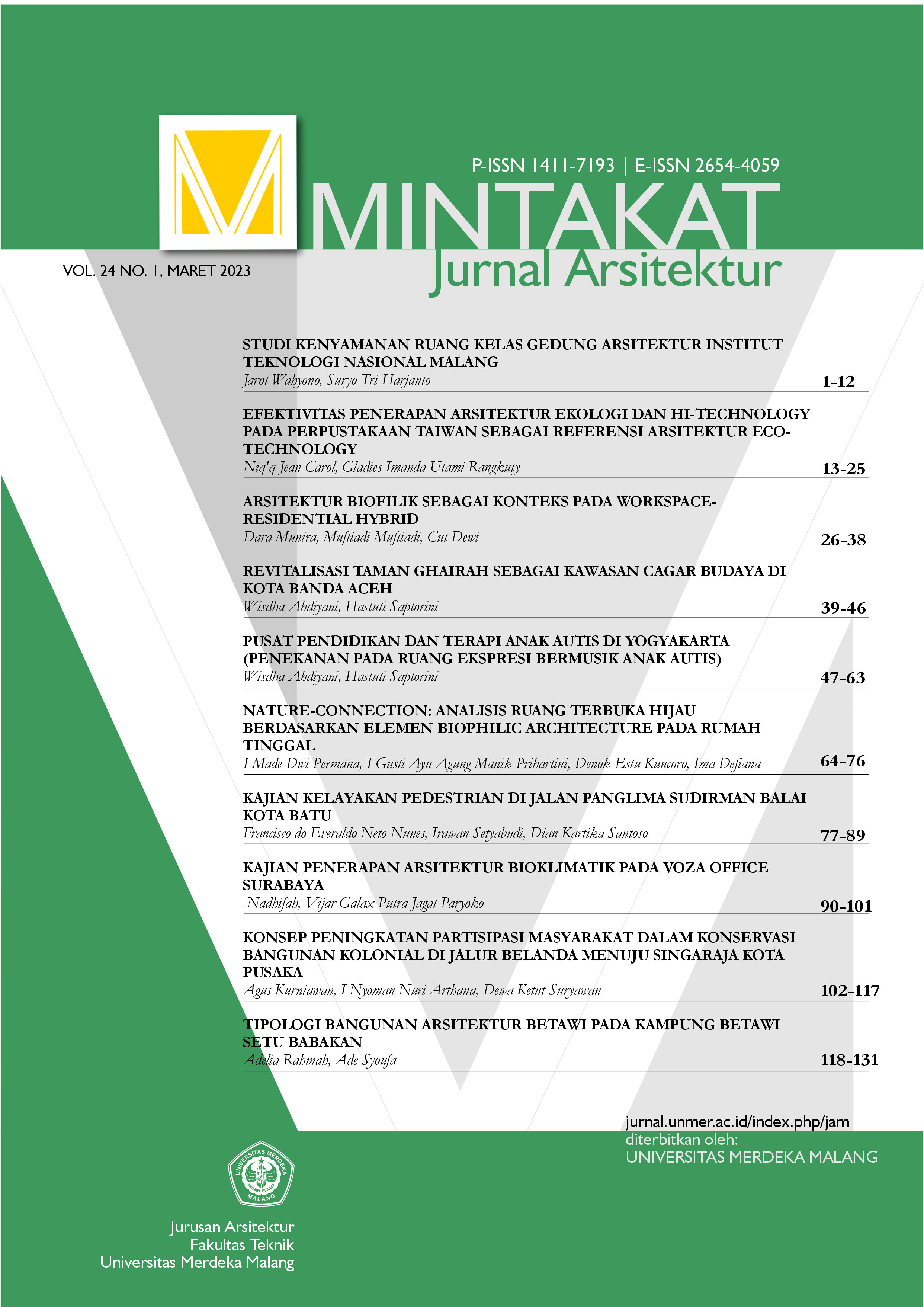Arsitektur Biofilik sebagai Konteks pada Workspace-Residential Hybrid
DOI:
https://doi.org/10.26905/jam.v24i1.9139Keywords:
biofilik, hybrid residential, workspaceAbstract
Fenomena Work from Home adalah perubahan perilaku dan kebutuhan manusia yang paling terlihat semenjak pandemi Covid-19. Kebutuhan manusia akan tempat tinggal sekaligus menjadi tempat kerja meningkat akibat pembatasan individu untuk keluar dari rumah. Penelitian ini dilakukan berdasarkan fenomena tersebut dan bertujuan untuk mengkaji kebutuhan individu terhadap hibridisasi rumah tinggal dengan workspace sebagai salah satu upaya adaptasi pasca pandemi Covid-19. Penelitian ini menggunakan metode deskriptif-kualitatif dengan membandingkan kondisi eksisting beberapa rumah hunian dari beberapa kota berbeda yang mengalami dampak dari masa pandemi Covid-19 dan memerlukan workspace sebagai area bekerja di dalam rumah. Penelitian ini melakukan evaluasi beberapa rumah tinggal dan mengusulkan konsep workspace-residential hybrid dengan pendekatan arsitektur biofilik, yang diharapkan mampu memenuhi kebutuhan hybrid workspace pada masa pasca pandemi.
--------------------------------------------------------------------------------------------
The phenomenon of Work from Home is the most visible change in human behavior and needs since the post-Covid-19 pandemic. The human need for a place to live which is also becoming a place to work has increased due to restrictions on individuals leaving their homes. This research was conducted based on this phenomenon and aims to examine individual needs for hybridization of residential homes and workspaces as an effort for adaptation after the Covid-19 pandemic. This study uses a descriptivequalitative method by comparing the existing conditions of several residential houses from several different cities that have experienced the impact of the Covid-19 pandemic and require a workspace as an area to work at home. This research resulted in an evaluation of several residential houses and the concept of a hybrid workspace and residential with a biophilic architectural approach which is expected to be able to meet the needs of a hybrid workspace in the post-pandemic.
Downloads
References
Aristizabal, S., Byun, K., Porter, P., Clements, N., Campanella, C., Li, L., Mullan, A., Ly, S., Senerat, A., Nenadic, I.Z., Browning, W.D., Loftnessj, V., Bauer, B. (2021). Biophilic Office Design: Exploring The Impact of A Multisensory Approach On Human Well-Being. Journal of Environmental Psychology Volume 77, 1-15.
Ariyani, I. (2020). Penyesuaian Setting Ruang Untuk Bekerja Dari Rumah pada Masa Pandemi Covid-19. Lintas Ruang: Jurnal Pengetahuan & Perancangan Desain Interior. 8(1) 9-22.
Bergefurt, L., Weijs-Perrée, M., Appel-Meulenbroek, R., Arentze, T., & de Kort, Y. (2022). Satisfaction with activity-support and physical home-workspace characteristics in relation to mental health during the COVID-19 pandemic. Journal of Environmental Psychology, 81(February).
Badan Pusat Statistik. (2020). Analisis Hasil Survey Dampak Covid-19 Terhadap Pelaku Usaha Jilid II. Jakarta: Badan Pusat Statistik.
Browning, W., Ryan, C., & Clancy, J. (Terrapin, 2014)12. Fourteen Patterns of Biophilic Design: Improving Health & Well-Being in the Build Environment. New York: Terrapin Bright Green.
Felstead, A., & Jewson, N. (2000). Work, at home. Routledge.
Francescato, G., Weidemann, S., & Anderson, J. R. (1989). Evaluating the built environment from the users’ point of view: an attitudinal model of residential satisfaction. Building Evaluation, 6(3), 261–297.
Groat, L., & Wang, D. (2002). Architectural Research Methods. Canada: John Wiley & Sons Inc.
Hensher, D. A., Wei, E., & Beck, M. J. (2022). The Impact that COVID-19 and working from home has had on the amount of main location office space retained and the future use of rented satellite offices. Journal of Transport Geography (under Review), 130(July 2022), 184–195.
Kementerian Sosial RI. (2017). Rehabilitasi Sosial Rumah Tidak Layak Huni dan Sarana Prasarana Lingkungan. Retrieved May 27, 2017, from https://www.kemsos.go.id/modules.php?name=Content&pa=showpage&pid=24&page=1
Kasiati & Rosmalawati, N. W. D. (2016). Kebutuhan dasar manusia I. Jakarta: KEMENKES RI.
Marlina, R. (2018). Pembagian zona dalam sebuah ruangan. Verdant.id. https://verdant.id/artikel/pembagian- zona-dalam-sebuah-ruangan/
Murray, H. A. (1938). Explorations in Personality. New York: Oxford University Press.
Moniaga,C. (2021). Arsitektur Biophilic Untuk Mendukung Pengembangan Desain Hunian Di Era Kegiatan Work From Home (Pandemic Covid 19) Studi Kasus Perumahan Naraya Bsb Semarang. Tesa Arsitektur. 19(1): 35-50.
Mohit, M. A., & Raja, A. M. M. A. K. (2014). Residential satisfaction-Concept, theories and empirical studies. Planning Malaysia: Urban Planning and Local Governance. Vol III (2014): 47–66.
Rianto, A. (2010), Metodologi Penelitian Sosial dan Hukum, Jakarta: Granit.
Rofiana, V. (2015). Dampak Pemukiman Kumuh terhadap Kelestarian Lingkungan Kota Malang (Studi Penelitian di Jalan Muharto Kel. Jodipan Kec. Blimbing Kota Malang). IJPA-The Indonesian Journal of Public Administration, 2(1), 40–57.
Sari, H. M., & Dinapradipta, A. (2019). Pendekatan Biofi(lik untuk Mengurangi Faktor Lingkungan Pemicu Asma pada Anak. Jurnal Sains dan Seni ITS. 8(2): G63-G68.
Soo, K. J., & Mo, K. J. (2017). The Relation between Housing Needs and Housing Function according to the Maslow’s Theory of Needs. KIEAE Journal, 17(4), 13–19.
Sturgeon, A. (2017). Creating Biophilic Buildings, 1st ed. Seattle:Ecotone Publishing.
Yin, R. K. (2011). Qualitative-Research-From-Start-To-Finish. New York: The Guilford Press.














